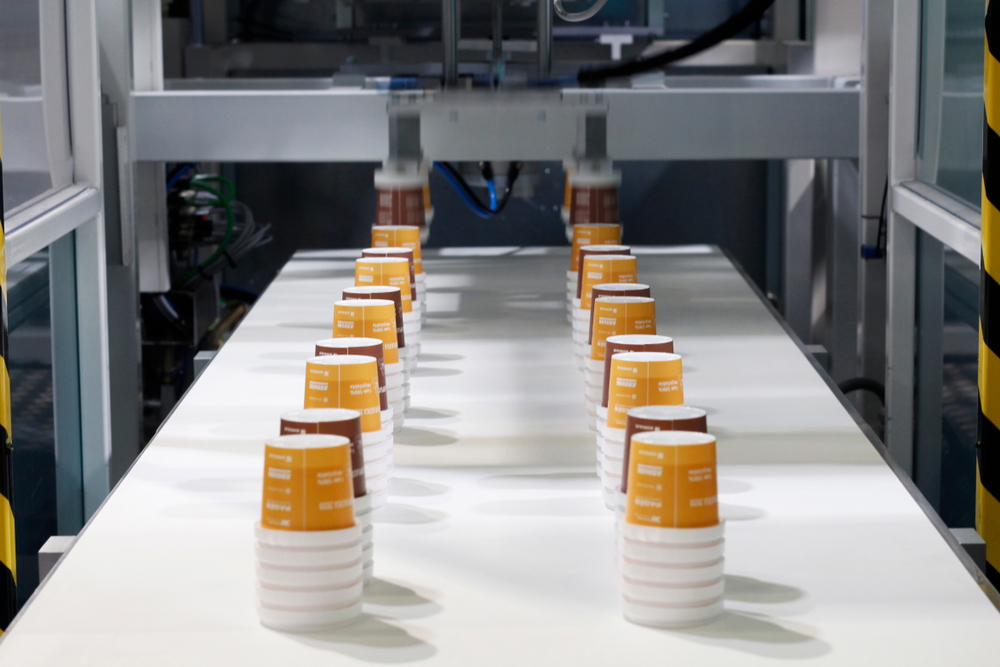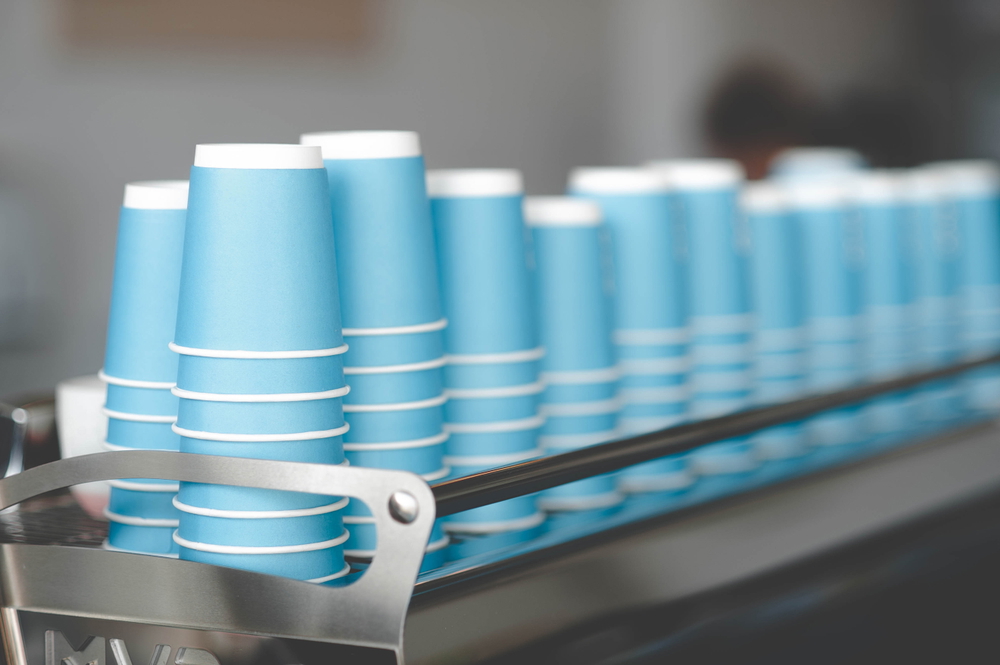The Process of Manufacturing of Paper Cups
By Anttoni Taimela · 10. June 2024
The manufacturing of paper cups is a precise process designed to deliver quality and convenience.
In this article, we detail each step, from sourcing eco-friendly materials to the advanced printing and quality control that ensures each cup’s integrity.
Journey from Forest to Factory
Imagine a tranquil forest where the air is fresh and the sound of wildlife surrounds you.
This is often the starting point for the paper cups cradling your favorite beverages. Paper cups begin their life as wood-derived food-grade paperboard, sourced from sustainably managed forests or recycled paper materials.
The process of creating paper cups is comprehensive and involves the following steps:
- Trees are meticulously selected.
- The bark is removed from the trees.
- The trees are chopped into small wood chips.
- The wood chips are transformed into pulp.
- The pulp is used to create the paper cups we use every day.
This cycle of creation is often sealed with eco-labels like FSC and PEFC, ensuring that the paper coffee cups we hold, as well as paper coffee cups in general, are products of conscientious stewardship and responsible sourcing practices.
Steps in the Paper Cup Production Process
 fragment machine production of disposable plastic cups
fragment machine production of disposable plastic cups
The creation of a paper cup involves several steps in the paper cup manufacturing process:
- Sourcing of materials
- Preparation
- Shaping
- Coating
- Printing (printing process)
- Quality control
Each step is crucial in ensuring the production of high-quality paper cups through an efficient manufacturing process.
This fascinating production process ensures that the disposable cups, specifically paper cups, are made to meet the highest standards of quality and functionality.
Design and Material Selection
Before a paper cup can take shape, the right raw materials must be chosen with care.
The main raw material for paper cups comes in various forms; normal paper, FSC certified paper, and FSI certified paper are all contenders based on the manufacturer’s requirements and sustainability goals.
The material selection phase is critical, as the paperboard must undergo a series of processes such as cleaning, pulp transformation, and bleaching to prepare it for the cup production.
Shaping and Forming Techniques
Transitioning from a flat sheet to a functional container is where the magic happens in paper cup manufacturing.
Circles of paper are first glued on a flat surface, providing the foundational shape of the cup.
Next, in the heart of the cup-forming machine, precise application of heat and pressure transforms the cup blanks into the familiar form we recognize—a perfect home for your latte, tea, or a coffee cup.
It is this combination of heat and pressure that ensures the cups are sealed properly, making them both food safe and ready to hold your favorite liquid without a second thought.
Finishing Touches: Printing and Coating
As the paper cup nears completion, it’s time to add personality and protection.
Custom prints are applied using techniques such as flexographic or offset printing, allowing businesses to brand their cups with logos, designs, and messages.
Flexographic printing, in particular, offers versatility and can be adapted to a wide array of materials, including the paper used for cups.
To ensure these vessels can contain your hot or cold drinks, a thin layer of plastic coating is applied to the interior, providing the necessary barrier to prevent leaks and maintain drink integrity.
For eco-conscious consumers, environmentally friendly alternatives to traditional plastic coatings, such as water-based dispersions, are gaining traction, reducing the environmental footprint of these everyday items.
Innovations in Eco-Friendly Cup Manufacturing
 paper cup production
paper cup production
In a world where sustainability is no longer optional, paper cup manufacturers are stepping up with new innovations.
Biodegradable and compostable materials, including plant-based PLA linings, are becoming the norm in the creation of environmentally friendly pla paper cups.
These eco-friendly paper coffee cups are not just a statement but a commitment to the future, earning certifications like Ecovadis and Flustix that resonate with consumers’ growing environmental consciousness.
From the forests of Finland comes an innovative disposable paper cup that stands firm against both hot and cold liquids, showcasing the versatility and adaptability of modern cup manufacturing.
Moreover, the industry is leaning into CO2 neutral processes, such as tree planting, to offset emissions and pave the way for a greener future in paper cup production.
✅Ensuring Quality: From Production Line to Coffee Shop
Once the paper cup has been formed, printed, and coated, it must prove its worth.
In-house production processes maintain the highest standards of quality control and hygiene, ensuring that the paper coffee cups that reach coffee shops and consumers are impeccable.
Rigorous tests, including leakage checks with hot liquids, ensure that the cups perform under pressure and temperature without failure. This level of quality is essential in the competitive paper cup industry.
Pre-shipment inspections are the final gatekeepers in the quality assurance process.
They encompass a suite of evaluations ranging from safety and function testing to aesthetic checks and adherence to product specifications, guaranteeing that the cups meet both the coffee shop’s and the consumer’s exacting standards.
The Role of Disposable Cups in Modern Consumerism ☕
Disposable paper cups have become a staple of contemporary life, synonymous with on-the-go convenience in coffee shops, fast food restaurants, and various social settings.
Yet, despite their pervasiveness, the stark reality is that a staggering 99.75% of these cups don’t find their way into the recycling stream.
This alarming statistic has catalyzed a shift in consumer preference from single-use plastics to disposable paper cups, perceived as a more eco-friendly choice.
Businesses and consumers alike are awakening to the importance of sustainability, with initiatives like discounts for bringing reusable cups and educational programs to spotlight the environmental costs of disposable cups.
Progress in recycling infrastructure is being made, with a collective effort from manufacturers, waste management companies, and local governments to improve the recyclability of these ubiquitous containers.
Navigating the Environmental Impact
While paper cups offer a greener alternative to their plastic counterparts, the environmental impact is still a point of contention.
The plastic coating that enables paper cups to hold liquids also complicates their recycling, contributing to a dismal recycling rate.
Innovations such as plastic-free cups that fully degrade or are recyclable present an environmentally friendly solution that mitigates the climate impact.
Legal measures, like bans on single-use plastic items, including plastic cups, have also nudged the market toward paper cups, reducing the influx of plastic waste.
The debate between single wall and double wall cups is not just about heat retention but also about environmental efficiency.
Single wall cups are lighter on resources and emissions during production and transportation, offering a subtler footprint on our planet.
Summary 📜
As we’ve journeyed from the forest to the final sip, the life of a paper cup has unfolded as a narrative of innovation, sustainability, and modern necessity.
In every coffee shop encounter with a paper cup, we hold a product of meticulous craftsmanship and environmental consideration.
Let’s continue to be mindful of our choices, recognizing the impact of each disposable cup on our world and the steps we can take toward a more sustainable future.
Frequently Asked Questions
Are paper cups more environmentally friendly than plastic cups?
Yes, paper cups are generally considered more eco-friendly than plastic cups because they are often made from sustainably sourced materials and feature biodegradable or compostable linings. However, their recycling rates are still low.
Can paper cups be recycled?
Yes, paper cups can be recycled, but the plastic coating makes recycling more challenging, so innovations in cup design and recycling infrastructure are being developed to improve their recyclability.
What is the difference between single wall and double wall paper cups?
The main difference is that single wall paper cups have one layer and are best for cooler drinks, while double wall cups have an extra layer for better insulation, making them perfect for hot beverages.
How are paper cups printed and customised?
Paper cups are customised using techniques like flexographic or offset printing, which offer a wide range of colours and designs, ensuring durability and resistance to wear, even when exposed to moisture and chemicals.
What are some of the eco-friendly innovations in paper cup manufacturing?
Some eco-friendly innovations in paper cup manufacturing include the use of biodegradable and compostable materials, plant-based PLA linings, and efforts to achieve CO2 neutral manufacturing processes. Additionally, cups are designed to resist both hot and cold liquids, reducing the need for multiple types of cups.

